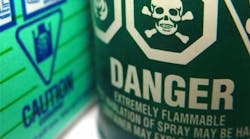For product manufacturers who sell consumer products in all 50 states, the legal and regulatory patchwork is likely to get more complex in 2015.
In 2008, several states passed a new type of state-level environmental law. These laws were not focused on facilities located in those states and the emissions into air, water and land from those facilities, as traditional state-level environmental laws. Rather, these laws were focused on chemical ingredients contained in consumer products sold in these states. The most famous and comprehensive of these were the laws in California implementing its Green Chemistry Initiative. In the same year, the State of Washington and Maine also passed similar, yet far narrower laws, directed at fewer chemicals and a smaller set of children’s products.
Now in 2015, California is still struggling to implement its law and develop compliance instructions for manufacturers to follow. It appears that California will spend at least another year engaged in the development of further regulations, work plans and guidance for just its first three products. In contrast, the states of Washington and Maine are well into the implementation of their laws and manufacturers across entire industries have had compliance obligations for several years.
The state of Washington’s 2008 law, the Children’s Safe Products Act (Chapter 70.240 RCW) is primarily a reporting statute and requires manufacturers of children’s products sold in Washington to report if their product contains a chemical of high concern to children. The state of Washington quickly adopted regulations, and manufacturers began complying immediately. The reporting rule regulations phased in compliance obligations based on type of product (based on the product’s level of exposure risk) and size of manufacturer. The first set of reports were filed in August 2012 by the largest manufacturers (with over $1 billion in sales), and manufacturers by their groupings have filed in four subsequent filing periods. The next filing deadline is August 2015 when compliance obligations will reach smaller companies with over $100,000 in sales. Similarly, the state of Maine’s 2008 law, the Toxic Chemicals in Children’s Products Act, has implementing regulations adopted and compliance is well underway.
Since California’s laws was the most comprehensive and applied to nearly all products sold (exceptions include FDA-approved drugs, EPA-approved pesticides and food), many states were reluctant to pursue adoption of a similarly broad law and were waiting for California’s program to be implemented. Patience has worn thin.
The state legislatures are now reconvening for 2015 and it appears that at least three states - Washington, Oregon and New York - are seeking to pursue a comprehensive chemical and consumer product statutory authority. Others are beginning to dabble in this area with laws requiring each state to adopt lists of harmful chemicals, create websites for citizens to learn more or prohibit the use of specific chemicals in products sold in their states. (See Florida’s SB 374, Connecticut’s HR 5653 and Mississippi’s HB 175.)
Connecticut’s HB 5653 would require the state’s commissioner of public health to identify chemicals potentially harmful to children and report back to its legislature on the feasibility of phasing out or banning products containing those chemicals. Among other things, it would authorize the Commission of Public Health to require in-state manufacturers to consult with the Interstate Chemicals Clearinghouse (IC2) or other institutions outside the state about replacing with safer chemicals.
Building off the lists already prepared by Maine, Washington and Minnesota, Florida’s HB 607 and SB 374 would require its state’s Department of Public Health to publish on its website a list of at least 50 chemicals of high concern in products sold to pregnant women and for use by children or present in their surroundings (home, school, childcare facility).
Washington has several bills introduced. HB 1472 and SB 5406 would require the state to adopt a list of 150 priority chemicals and select 20 for development of action plans. They would also link these chemicals to the state’s procurement policies. A third bill, SB 5056 would prohibit the sale of children’s products with more than 100 ppm of certain flame retardants (TDCPP, TCEP, DecaBDE, HBCD) and require the selection of two (2) chemicals of high concern for action plan.
Oregon’s HB 2572 would require all consumer products sold in Oregon after January 1, 2016 to have a carbon footprint label. If enacted, this would create several problems for product manufacturers whose labels are already crowded with legally-mandated language. There are numerous methods, none of which is universally-accepted, for measuring a product’s carbon footprint and it is unclear what methods Oregon would adopt. Regardless of which method is required, the costs will be high and it is questionable what the label will actually be communicating to consumers or the product choices they make.
New York, like Oregon and Washington, is seeking to establish a more comprehensive approach to regulating chemicals in children's products.—Maureen Gorsen
Oregon’s SB 478 requires its Oregon Health Authority to establish a list of high priority chemicals of concern used in children’s products, and require manufactures to provide notifications to Oregon. It allows Oregon to enter into data sharing agreements with other states and authorizes participation in the Interstate Chemicals Clearinghouse (despite the fact that Oregon has been actively participating for several years). It requires Oregon to at least include the chemicals that are on the state of Washington’s lists created by other federal, state and nongovernmental organizations.
Oregon’s bill would require manufacturers to provide notifications, hazard assessments and to pay fees to the state to test its products. It would authorize alternatives assessments to be required in Oregon for chemicals that are on the state of Washington’s lists but not its own. It authorizes Oregon to specify that the notices manufacturers are required to provide be provided to the IC2. The IC2 is a loose coalition of state environmental regulatory agencies that currently share tools and techniques to regulate consumer products, but whose role may be expanding to an actual regulatory role if the Oregon and other state bills authorizing use of IC2 for state regulatory implementation pass this year. The use of a supra-state entity in this way raises novel constitutional and federalism issues, particularly since the IC2 reports to no single legislative body.
New York, like Oregon and Washington, is seeking to establish a more comprehensive approach to regulating chemicals in children’s products. New York’s S. 2408 would require its Department of Environmental Conservation to establish a website listing chemicals of high concern. Like Florida’s two bills, S.2508 authorizes New York to build on the lists created by Maine and Washington and California’s Proposition 65 list, but not California’s safer consumer products chemical of concern list. This may be an indication that Washington and Maine’s program are worthy of imitation, but California’s is not.
Once the New York list is created, manufacturers will be required to report use of the chemical to the state and allows for the establishment of a fee to be paid by manufacturers using chemicals on the list. Again, the coordination of the states belonging to the IC2 is evidenced, as S. 2408 allows for use of a single form for use by all the states that are members and that have laws requiring chemical of concern notification requirements.




